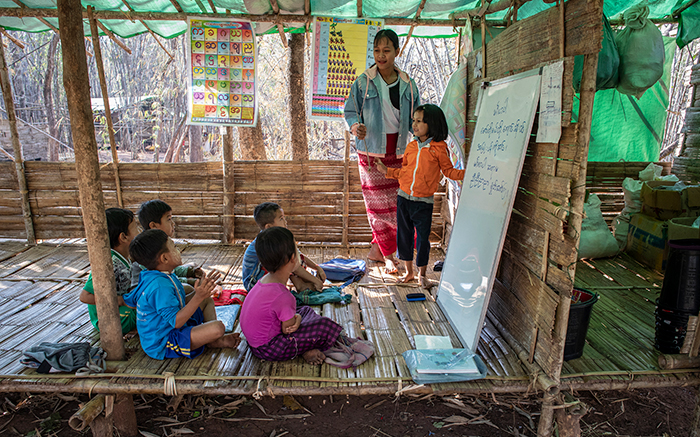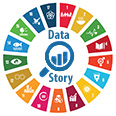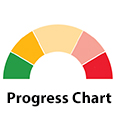Quality education

A volunteer teacher gives a lesson to children in a camp for displaced people in eastern Myanmar.
© OCHA/Siegfried ModolaGlobal upper secondary school completion growth slows yet Eastern and South-Eastern Asia displays remarkable progress
Between 2015 and 2023, the primary school completion rate increased from 85 per cent to 88 per cent, the lower secondary completion rate from 74 per cent to 78 per cent, and the upper secondary completion rate from 53 per cent to 59 per cent. However, only two in three children in sub-Saharan Africa complete primary school on time.
Progress in upper secondary completion slowed from 1.3 percentage points annually (2010-2015) to 0.9 percentage points annually (2015-2023), with Oceania experiencing negative growth. Yet some regions made notable progress. Eastern and South-Eastern Asia was the fastest growing region, with the completion rate climbing from 63 per cent in 2015 to 74 per cent in 2023.
Globally, girls' completion rates exceed those of boys by 2 to 3 percentage points in both primary and secondary education. At the upper secondary level, girls hold a notable advantage, with a 14 percentage-point gap in Eastern and South-Eastern Asia, 8 points in Latin America and the Caribbean, and 4 to 5 points in most other regions. In Central and Southern Asia and sub-Saharan Africa, boys maintain a slight lead of 2 to 3 percentage points. These regional disparities underscore the need for targeted efforts to achieve equal educational opportunities for all children.
Upper secondary school completion rate, 2015 and 2023 (percentage)

COVID-19 and other factors have exacerbated declines in reading and mathematics
Based on the 2022 Programme for International Student Assessment test at the end of lower secondary school in 81 member and partner countries of the Organisation for Economic Co-operation and Development, from 2018 to 2022, mean performance in mathematics plummeted by a record 15 points. Reading scores declined by 10 points, twice the previous record. Reading proficiency followed a downward trajectory for a decade prior to these results; mathematics scores were relatively stable from 2003 to 2018. An unprecedented drop highlights the profound impact of the COVID-19 pandemic on global education.
Significant data shortfalls in tracking learning outcomes, especially in early education, pose challenges in assessing global trends and disparities among countries. With data available for only one in five countries at the end of primary school, recent initiatives to close the gaps show promise in expanding cross-national assessments.
An urgent need for enhanced climate change and sustainability education and teacher training
Although 90 per cent of countries report that they mainstream sustainable development and global citizenship subjects in national education systems, evidence suggests scattered uptake. A 2023 study of more than 530 ninth grade science and social science curricula found that 69 per cent did not mention climate change and 66 per cent omitted sustainability. Despite claims by some teachers that these topics were covered, 50 per cent admitted to not teaching them. Three quarters of countries expressed intentions to revise their curricula within the next three years to prioritize climate change and sustainability. Simply revising curricula may not be sufficient, however, if teachers lack the confidence or willingness to teach these subjects. Comprehensive support from schools, training institutions, communities and governments is essential to encourage educators to effectively transmit sustainability principles to future generations.
Universal pre-primary education is hindered by inadequate legal guarantees and financial barriers
Globally, pre-primary education has stagnated since the SDGs were agreed. Seven out of 10 children globally attended organized learning one year before the official primary entry age in 2022, a rate unchanged since 2015. In sub-Saharan Africa and Northern Africa and Western Asia, less than half of children attended pre-primary school, despite previous progress.
COVID-19 reversed growth in pre-primary education, causing a decline of 1.5 percentage points. This particularly impacted the poorest children, as pre-primary education can mitigate disadvantages. Legal guarantees for free and compulsory pre-primary education are crucial to school readiness and equal opportunities, yet only a quarter of countries make it compulsory and only half offer it for free. Financial barriers persist in regions where the private provision of education is prevalent; in sub-Saharan Africa, 32 per cent of pre-primary students attend private institutions. Overall, children from the richest households are twice as likely to attend preschool compared to those from the least affluent households.
Participation rate in organized learning (one year before the official primary entry age), 2015-2022 (percentage)

Note: No data are available for Eastern and South-Eastern Asia between 2015 and 2022.
Lags in basic services in schools continue to marginalize girls and students with disabilities
Despite basic services in schools being essential for fair learning opportunities, progress has been slow, particularly affecting students with disabilities and girls. Globally, only half of primary schools and just 62 per cent of secondary schools have basic infrastructure for students with disabilities. In Latin America and the Caribbean, only a third of primary schools can accommodate students with disabilities. Globally, over 20 per cent of primary schools have no separate sanitation facilities for girls. A lack of handwashing facilities in 2 out of 10 schools poses health risks, especially during pandemics.
Between 2021 and 2022, the growth rate in schools' Internet access for pedagogical purposes doubled globally and even tripled in some regions. At the upper secondary level, 91 per cent of schools had access to electricity, 81 percent had computers and 69 per cent were connected to the Internet. Significant disparities remained, particularly in sub-Saharan Africa, where less than a third of primary schools and about half of secondary schools had access to electricity, hindering the use of technology.
Proportion of primary schools with access to basic services (percentage) by type of service, 2022 or most recent year

A substantial number of teachers are not trained according to minimum standards in their country
Teachers are the single most important factor in student learning. Yet a significant teacher qualification gap persists globally. On average, 15 per cent of teachers lack minimum qualifications, hindering progress across all levels of education.
Sub-Saharan Africa faces the steepest challenge, with only 60 per cent of pre-primary teachers meeting standards compared to 90 per cent in Europe and Northern America in 2022. At the primary level, 7 out of 10 teachers in sub-Saharan Africa met minimum required qualifications compared to 9 out of 10 in most other regions. Teacher shortages and limited in-service training compound this problem, particularly in sub-Saharan Africa, where enrolment growth outpaces teacher hiring. Inconsistency in national teacher qualification standards further obstructs progress. The International Standard Classification of Teacher Training Programmes was endorsed in 2021 to define a minimum global standard for trained teachers but has yet to be widely implemented.
Proportion of primary school teachers with minimum required qualifications, 2015 and 2022 or most recent year (percentage)


